HAPPY LOVABLE GIRAFFE
The giraffe (Giraffa) is a genus of African even-toed ungulate mammals, the tallest living terrestrial animals and the largest ruminants. The genus currently consists of one species, Giraffa camelopardalis, the type species. Seven other species are extinct, prehistoric species known from fossils. Taxonomic classifications of one to eight extant giraffe species have been described, based upon research into the mitochondrialand nuclear DNA, as well as morphological measurements of Giraffa, but the IUCN currently recognizes only one species with nine subspecies.
| Ruminantia |
| |||||||||||||||||||||||||||
The giraffe's chief distinguishing characteristics are its extremely long neck and legs, its horn-like ossicones, and its distinctive coat patterns. It is classified under the family Giraffidae, along with its closest extant relative, the okapi. Its scattered range extends from Chad in the north to South Africa in the south, and from Niger in the west to Somalia in the east. Giraffes usually inhabit savannahs and woodlands. Their food source is leaves, fruits and flowers of woody plants, primarily acacia species, which they browse at heights most other herbivores cannot reach. They may be preyed on by lions, leopards, spotted hyenas and African wild dogs. Giraffes live in herds of related females and their offspring, or bachelor herds of unrelated adult males, but are gregarious and may gather in large aggregations. Males establish social hierarchies through "necking", which are combat bouts where the neck is used as a weapon. Dominant males gain mating access to females, which bear the sole responsibility for raising the young.
The giraffe has intrigued various cultures, both ancient and modern, for its peculiar appearance, and has often been featured in paintings, books, and cartoons. It is classified by the International Union for Conservation of Nature as Vulnerable to extinction, and has been extirpatedfrom many parts of its former range. Giraffes are still found in numerous national parks and game reserves but estimations as of 2016 indicate that there are approximately 97,500 members of Giraffa in the wild, with around 1,144 in captivity.
There are an estimated 90,000 individuals of Giraffa in the wild, with 1,144 currently in captivity.[28][30]
There are also seven extinct species of giraffe, listed as the following:
- †Giraffa gracilis
- †Giraffa jumae
- †Giraffa priscilla
- †Giraffa punjabiensis
- †Giraffa pygmaea
- †Giraffa sivalensis
- †Giraffa stillei
Behaviour and ecology
Habitat and feeding
During the wet season, food is abundant and giraffes are more spread out, while during the dry season, they gather around the remaining evergreen trees and bushes.[4] Mothers tend to feed in open areas, presumably to make it easier to detect predators, although this may reduce their feeding efficiency.[70] As a ruminant, the giraffe first chews its food, then swallows it for processing and then visibly passes the half-digested cud up the neck and back into the mouth to chew again.[52]:78–79 It is common for a giraffe to salivate while feeding.[53]:27 The giraffe requires less food than many other herbivores because the foliage it eats has more concentrated nutrients and it has a more efficient digestive system.[4] The animal's faeces come in the form of small pellets.[7] When it has access to water, a giraffe drinks at intervals no longer than three days.[45]Giraffes usually inhabit savannahs and open woodlands. They prefer Acacieae, Commiphora, Combretum and open Terminalia woodlands over denser environments like Brachystegia woodlands.[40]:322 The Angolan giraffe can be found in desert environments.[83] Giraffes browse on the twigs of trees, preferring trees of the subfamily Acacieae and the genera Commiphora and Terminalia,[4] which are important sources of calcium and protein to sustain the giraffe's growth rate.[11] They also feed on shrubs, grass and fruit.[40]:324 A giraffe eats around 34 kg (75 lb) of foliage daily.[45] When stressed, giraffes may chew the bark off branches. Although herbivorous, the giraffe has been known to visit carcasses and lick dried meat off bones.[40]:325
Giraffes have a great effect on the trees that they feed on, delaying the growth of young trees for some years and giving "waistlines" to trees that are too tall.[45] Feeding is at its highest during the first and last hours of daytime. Between these hours, giraffes mostly stand and ruminate. Rumination is the dominant activity during the night, when it is mostly done lying down.[45]
Reproduction in giraffes is broadly polygamous: a few older males mate with the fertile females. Male giraffes assess female fertility by tasting the female's urine to detect oestrus, in a multi-step process known as the flehmen response.[85][89] Males prefer young adult females over juveniles and older adults.[85] Once an oestrous female is detected, the male will attempt to court her. When courting, dominant males will keep subordinate ones at bay.[89] A courting male may lick a female's tail, rest his head and neck on her body or nudge her with his horns. During copulation, the male stands on his hind legs with his head held up and his front legs resting on the female's sides.[45]
Giraffe gestation lasts 400–460 days, after which a single calf is normally born, although twins occur on rare occasions.[92] The mother gives birth standing up. The calf emerges head and front legs first, having broken through the fetal membranes, and falls to the ground, severing the umbilical cord.[7] The mother then grooms the newborn and helps it stand up.[53]:40 A newborn giraffe is 1.7–2 m (5.6–6.6 ft) tall.[47][48][49] Within a few hours of birth, the calf can run around and is almost indistinguishable from a one-week-old. However, for the first 1–3 weeks, it spends most of its time hiding;[93] its coat pattern providing camouflage. The ossicones, which have lain flat while it was in the womb, become erect within a few days.[45]
The length time in which offspring stay with their mother varies, though it can last until the female's next calving.[93] Likewise, calves may suckle for only a month[40]:335 or as long as a year.[45][89] Females become sexually mature when they are four years old, while males become mature at four or five years. Spermatogenesis in male giraffes begins at three to four years of age.[94] Males must wait until they are at least seven years old to gain the opportunity to mate.[45][53]:40Mothers with calves will gather in nursery herds, moving or browsing together. Mothers in such a group may sometimes leave their calves with one female while they forage and drink elsewhere. This is known as a "calving pool".[93] Adult males play almost no role in raising the young,[40]:337 although they appear to have friendly interactions.[85] Calves are at risk of predation, and a mother giraffe will stand over her calf and kick at an approaching predator.[45] Females watching calving pools will only alert their own young if they detect a disturbance, although the others will take notice and follow.[93]
Giraffes are usually found in groups. Traditionally, the composition of these groups has been described as open and ever-changing.[84]Giraffes were thought to have few social bonds and for research purposes, a "group" has been defined as "a collection of individuals that are less than a kilometre apart and moving in the same general direction."[85] More recent studies have found that giraffes do have long-term social associations and may form groups or pairs based on kinship, sex or other factors. These groups may regularly associate with one another in larger communities or sub-communities within a fission–fusion society.[86][87][88] The number of giraffes in a group can range up to 44 individuals.[88]
Giraffe groups tend to be sex-segregated[88] although mixed-sex groups made of adult females and young males are known to occur. Particularity stable giraffe groups are those made of mothers and their young,[85] which can last weeks or months.[89] Social cohesion in these groups is maintained by the bonds formed between calves.[40]:330[85]Female association appears to be based on space-use and individuals may be matrilineally related.[88] In general, females are more selective than males in who they associate with in regards to individuals of the same sex.[87] Young males also form groups and will engage in playfights. However, as they get older males become more solitary but may also associate in pairs or with female groups.Giraffes are not territorial,[7] but they have home ranges.[45] Male giraffes occasionally wander far from areas that they normally frequent.[40]:329
Although generally quiet and non-vocal, giraffes have been heard to communicate using various sounds. During courtship, males emit loud coughs.[45] Females call their young by bellowing. Calves will emit snorts, bleats, mooing and mewing sounds. Giraffes also snore, hiss, moan, grunt and make flute-like sounds,[45][90] and possibly communicate over long distances using infrasound[91]—though this is disputed.[90] During nighttime, giraffes appear to hum to each other above the infrasound range for purposes which are unclear.[90]
10 Things You Might Not Know about Giraffes
My favorite animal to watch while we were on our SkySafari was the giraffe. Seemingly ungainly and often the butt of bad jokes, I found them to be majestic creatures to watch. They are extremely curious and sure to steal your heart with their long necks, beautiful patchwork coat, and lovable nature. Despite that they are one of the most recognizable animals in the animal kingdom, there are a lot of unknown facts about them. We had terrific guides throughout our SkySafari that were a wealth of knowledge, and I certainly learned a lot! Here are 10 things you might not know about giraffes.
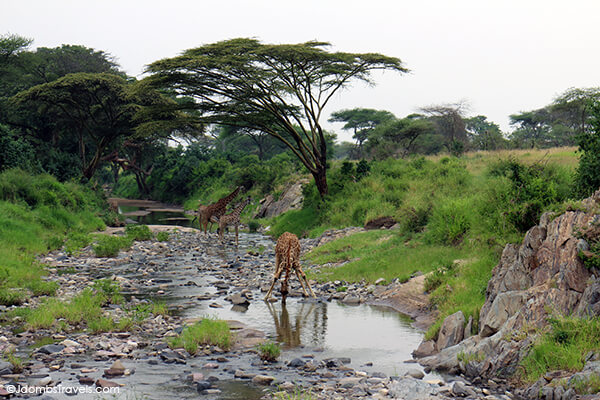 1. Giraffes can go a really long time without drinking water.
1. Giraffes can go a really long time without drinking water.
Until you see it, you don’t realize how hard the world’s tallest animal has it. Sure, they may be able to reach the best leaves at the very top of the trees. But imagine the effort that giraffes have to go through just to get a drink of water. They have to get into a pretty awkward position, spreading their front legs wide and craning their neck downward. Not only does it strain their neck, but the awkward position leaves them extremely vulnerable to predators like crocodiles. To help with this, their digestive system can obtain almost all the water that they need from the leaves that they eat. Adult giraffes only need to drink once every couple of days.
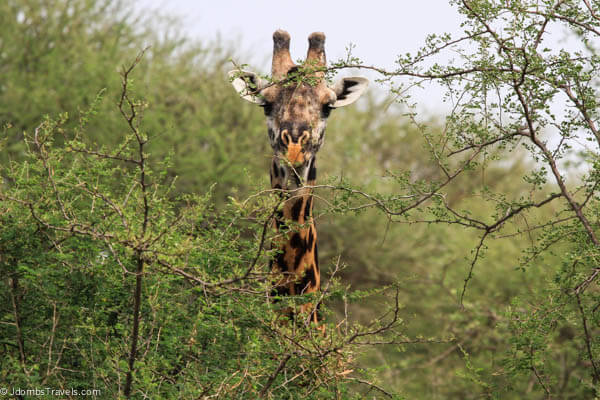 2. You can tell if a giraffe is male or female by looking at the horns.
2. You can tell if a giraffe is male or female by looking at the horns.
Both male and female giraffes have horns, but the tops of the horns on a male are almost always bald while a female’s horns will be completely covered with hair. This is because males establish dominance by fighting with other males and the hair on top of the horns gets torn off. Females don’t fight, so they never lose the hair on their horns.
 3. Giraffes weigh more than your car.
3. Giraffes weigh more than your car.
Giraffes look thin because they are so tall, but an adult male can weigh up to 3600 pounds and an adult female weighs on average 1800 pounds. The average sedan in the United States tips in between 1800 and 3000 pounds
4. Giraffes can run. Fast.
Though most of the time you’ll see giraffes walking leisurely around, they can run. Their long legs help them run up to 35 miles per hour over short distances or to cruise comfortably at around 10 miles per hour over longer distances.
 5. Giraffes and birds are friends.
5. Giraffes and birds are friends.
Giraffes have a symbiotic relationship with some birds, who help giraffes keep clean by eating mites and dirt off of them. What do the birds get in return? A tasty meal and a free ride
6. Baby giraffes are already 6 feet tall when born.
Baby giraffes weigh in at around 200 pounds and are already 6 feet tall when they are born. They learn to stand almost immediately at birth. They grow quickly, nearly doubling their height in their first year.
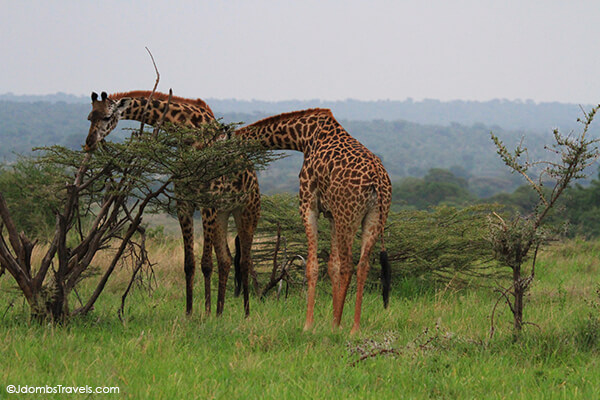 7. Giraffes eat around 75 lbs of foliage each day.
7. Giraffes eat around 75 lbs of foliage each day.
Most of the time on safari, you’ll find giraffes using their long necks to pluck leaves off the tops of trees. That’s because they spend most of their time eating each day and eat around 75 pounds of foliage every day. Their favorite meal is typically the leaves of acacia trees.
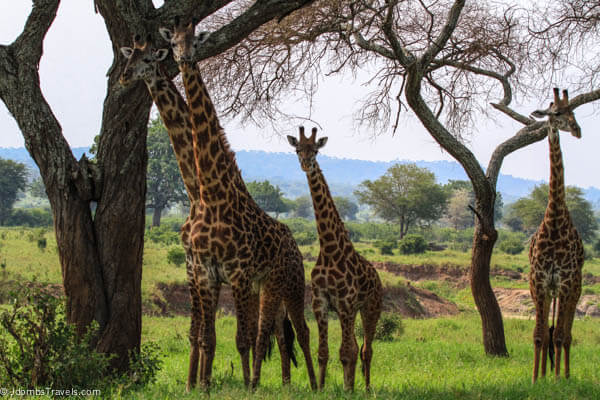 8. A herd of giraffes is called a tower.
8. A herd of giraffes is called a tower.
Giraffes can live in groups of up to 30 animals and the collective name for giraffes is a tower.
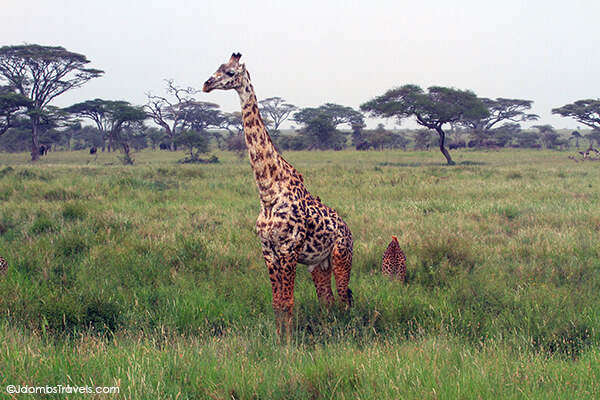 9. White giraffes are very rare.
9. White giraffes are very rare.
No pure albino giraffes have ever been discovered, but rare white giraffes do exist. White giraffes still do have some pigmentation and dark eyes. Because they are so rare, it was a special treat to see one in Serengeti National Park.
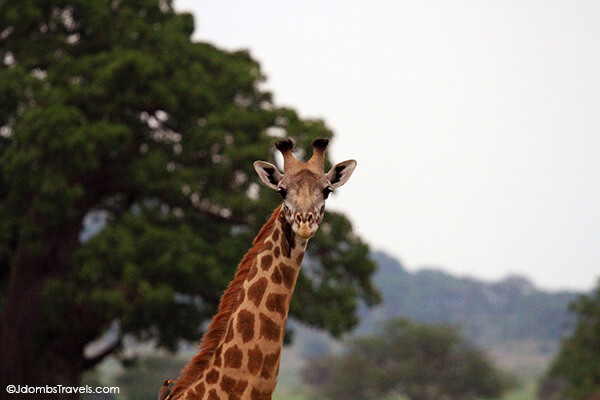 10. No two giraffes’ spotted coats are alike.
10. No two giraffes’ spotted coats are alike.
While the different sub-species of giraffes can appear to be similar, all giraffes have a unique pattern. Their spots also darken with age, and scientists have said that they can calculate their age from this darkening.
I have a questions about giraffe, read and answer down below!
1. The genus of giraffe currently consists of one species, that is....
A. Giraffa camelopardalisB. Giraffa jumae
C. Giraffa priscilla
D. Giraffa gracilis
2. Giraffe gestation lasts .... days.
A. 300-320
B. 400-500
C. 400-460
D. 360-400
3. Giraffes are not territorial but they have....
A. Hooves
B. Home protection
C. Forest living
D. Home ranges
4. Giraffes have a symbiotic relationship with some...
A. Horses
B. Birds
C. Cows
D. Rabbits
5. Baby giraffes weigh in at around .... pounds.
A. 300
B. 170
C. 200
D. 240





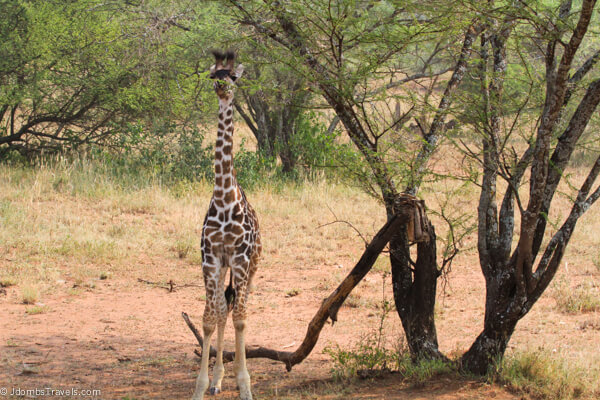


Komentar
Posting Komentar